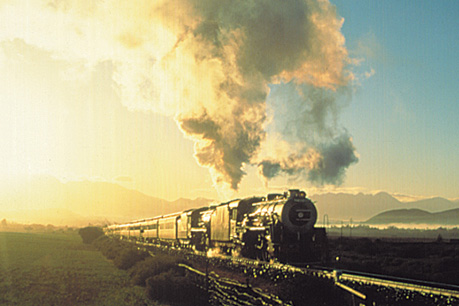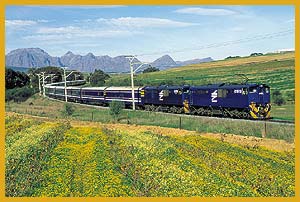|
The
Blue Train |
|
|
|
|
| RETURN
TO
THE HOMEPAGE
RMS WINDSOR CASTLE 1960
|
|
Successor to the famous prewar "The Union Limited" and "The Union Express". This feature celebrates the history of South Africa's premier express trains on the Pretoria - Johannesburg - Kimberley - Cape Town route, linking Pretoria and Johannesburg to Cape Town and the Union-Castle Line mail steamers arriving from England and Europe.
The Early Years:
Southern Africa has always attracted adventurous and romantic souls - discerning travellers who crossed the land in as much comfort as possible. During the early years of the development of the South African railway system (1895 - 1910) there were three main railway companies: Cape Government Railways, Natal Government Railway and Central South African Railways.
During this time a standard was set for passenger travel which could (considering the narrow gauge) equal the best anywhere in the world. Apart from passenger trains serving normal first, second and third class traffic, the Natal Government Railways had its “Corridor Express Trains”, while the Cape boasted its “Limited Express”, both these trains were (naturally) for first class passengers only. In 1901 Southern Rhodesia (now Zimbabwe) added another luxury train to the South African scene and called it the "Train de Luxe", also known as the “Zambesi Express”. During the latter part of 1903, the Central South African Railways introduced its own "Train de Luxe" (also believed to be known as the "Imperial Mail" and/or the "Africa Express") between Pretoria and Cape Town, which was the ultimate in luxury train travel for that time.
A Legend is Born:
Introduction of the "Union Express" and the "Union Limited":
In 1910 the four colonies became united into one as the Union of South Africa and so the railways become one as South African Railways (SAR). The company was renowned for the quality of its railway carriages and passenger trains. So much so in fact that when the new "Union Limited" and "Union Express" train services were launched in 1923 much of the stock came from the prestigious "Train de Luxe" that dated from 1903. These new trains were launched on the 26th November 1923 and formed a bi-weekly express service in both directions between Pretoria & Johannesburg and Cape Town. The schedule time for the 926 miles from Johannesburg to Cape Town was 29 hours and 21 minutes and in the reverse direction 30 hours. Southbound, the train with its distinctive blue and cream carriages (from 1933), was known as the 'Union Express' and departed on Mondays from Table Bay Docks at 10 am and conveyed first class passengers only and mails arriving by the incoming Union-Castle Line mail steamers from England and Europe. Passengers from Cape Town entrain at Monument station. On its return journey the train was called the “Union Limited” departed Pretoria at 06:30 am and Johannesburg at 08:45 am on Thursdays, conveying first class passengers only and mail for shipment by the Union-Castle Line mail steamers due to sail from Table Bay Docks at 4pm on Fridays. Passengers booked to Cape Town detrained at Monument station.
The southbound "Union Limited" also attached a carriage at Kimberley from Durban. While the northbound "Union Express" detached a carriage at Kimberley for Durban. This arrangement provided an express first class service between Durban and Cape Town thus reducing the travelling time between these two cities to 48 hours 4 minutes compared to its previous 65 hours 19 minutes. In 1925 observation cars were introduced on to the trains. During 1927 and 1929 articulated saloons were added to the Union Limited and Express, and the dining car “Protea” joined the train from 1933 to form the final formation of the Union trains until the outbreak of the Second World War. Thus by 1928, when the first luxury train was introduced between Johannesburg and Cape Town truly, luxurious train travel became a reality and on a par with the world famous European luxury trains operated by the famous Company de Wagon Lits (CIWL) such as the "Orient Express", "Nord Express" and the "Train Bleu". These new articulated saloons were the last word in luxury for the time. The compartments and coupes provided among other amenities, a decanter of water and glasses, washbasins with hot and cold water and an electric bell whereby the coach attendant could be summoned for dining car or valet service. Facilities for the valet service were provided in the attendant’s coupe which was incorporated in each saloon. For dining car service the attendant communicated with the kitchen by the telephone which was also provided in his coupe. These famous articulated saloons served on the Union Limited and Express for 11 years until being replaced by air conditioned carriages in 1933. The year 1933 also saw the introduction of a new dining car “Protea” which caused quite a stir. She was of vastly improved and modernised design and was furnished in very distinctive colours of azure blue and cream with a silver roof. Protea and her attendant kitchen car were then the only two vehicles in the train painted blue and cream. At this stage the articulated saloons, observation cars and vans were not painted - they had a varnished teak finish. However Protea’s colour scheme was so well received and successful that the decision was taken to adopt her colours for the "Union Limited" and "Union Express" trains. During the transition period the trains looked a little odd with some vehicles painted and some not but in due course by 1936 the two expresses became resplendent as complete sets in the now famous blue and cream livery. People soon began referring to the trains as 'those Blue Trains' and so... a legend was born.
During 1936 the two observation cars were rebuilt as lounge cars. These new lounge cars were marshalled next to the dining saloon. This allowed the compo van to be placed at the rear of the train while the mail van remained at the front behind the locomotive. Also in 1936 additional “deluxe” dining cars were introduced into service and some of these carriages were made available for use on the two premier expresses. These new cars were based on the Protea design. Kei, Umvoti, Umkomaas, and Nyanza were some of the new diners used on the trains. Some of these carriages survive today and are used on the Union Limited vintage steam safari train operated by the Transnet Heritage Foundation. The next major change to the rolling stock of these two premier express trains took place in 1939 when air conditioned vehicles were introduced. So continued the pre-war glory of the "Union Limited" and "Union Express", South Africa’s premier express trains, by now popularly nicknamed as “those blue trains”.
The Post-war Rebirth: The Legend reborn as "The Blue Train":
In 1942 the expresses were discontinued for the duration of the Second World War but sadly this was the end of their era as the "Union Limited" and "Union Express". In 1946 when the trains were reintroduced as air conditioned stock, on the Johannesburg to Cape Town route they became officially known as “The Blue Train” for the first time. The Blue Trains re-emerged as the premier express between the Union-Castle Line mail steamers in Cape Town and the industrial and economic hub of the country some 1 600 kilometers (994 miles) to the north- east. Only this time, the locomotives which hauled them carried a new name board: "The Blue Train".
Eventually steam reluctantly gave way to electrification and diesel as the grand all-steel blue icon adapted to progress, tirelessly journeying backwards and forwards. More and more people booked on The Blue Train for the sheer pleasure of the experience rather than the business orientation of its early history. But time and wear was taking its toll on the grand old train and in 1965, the decision to build a new Blue Train was taken by railways management and detailed design specifications were prepared. This specification noted that these new carriages were “to be of a standard of luxury and quality of material and workmanship equal to the best in the world.” Tenders came in from all over the world but it was the South African Union Carriage & Wagon Company outside Nigel (45km or 28 miles - east of Johannesburg) that won the commission in 1968.
While the new train was being created, a Blue Train Anniversary Special set off on a historic run from Johannesburg to Cape Town on April 11, 1969. It was a memorable occasion with two mighty old steam locomotives - the 16E 855 and 16E 859 - were resurrected to pull the anniversary train. The sense of gaiety on the platform next to the locomotive was briefly tempered by a scene, both heart warming and nostalgic. A contingent of retired drivers had formed up alongside the 16E to have a group photograph taken. Most of these men had, in their day, driven "The Blue Train" or its predecessors like the "Union Limited". What memories must have come rushing through their minds as they saw a steam locomotive once again at the head of South Africa's crack express.
The second generation stock for the "Blue Train" was completed in 1972. It became a symbol of luxury, sophistication and technological progress. Largely constructed by South Africans, the train incorporated the latest railway technology from Britain and Germany. Beyond the technology, The Blue Train's reputation for comfort, excellent service, food, punctuality, Irish linen, crystal and silverware in the heart of some of the world's most rugged and spectacular scenery, soon spread around the world.
The Legend lives on:
But in 1995, after 25 years of service, the time had come to build a new Blue Train. The Blue Train celebrated its 50th anniversary in February 1996, but its pedigree dates back a lot further to the 1920s. On August 1st, 1997, the third incarnation of "The Blue Train" glided out of Cape Town station heralding a new era in the history of luxury train travel. On 5 October 1998, the second new Blue Train commenced from Pretoria. Thus the Blue Train lives on a the ultimate luxury rail cruise experience operated by Transnet Limited as a truly great successor to the pre-war Union Limited and Express.
Today’s Blue Train operates on three main routes in addition to its traditional Pretoria - Kimberley - Cape Town route, these being:
However a version of the pre-war "Union Limited" and "Union Express" also lives on today operated by Transnet Heritage Foundation. Today’s Union Limited uses lovingly restored vintage carriages from the original pre-war "Union Limited" and "Union Express" trains on luxury vintage steam train safari excursions around South Africa and on the famous Garden Route from Cape Town to Port Elizabeth.
Useful Website Links:
Transnet Limited
Spoornet
The Blue Train - The Ultimate Luxury Rail Cruise Experience (Spoornet / Transnet Ltd, South Africa)
www.transnetheritagefoundation.co.za Transnet Heritage Foundation
www.transnetheritagefoundation.co.za/union_limited.htm The Union Limited Steam Safari (The Transnet Heritage Foundation, South Africa)
|
|
(c) Cruise Ship History Collection 2018 including www.thecunarders.co.uk A Edward Elliott |

